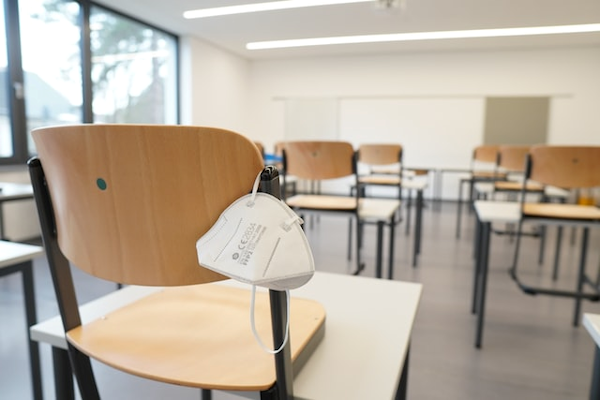SEJournal Online is the digital news magazine of the Society of Environmental Journalists. Learn more about SEJournal Online, including submission, subscription and advertising information.
 |
| The transmission of COVID-19 and airborne diseases is only one of the health risks in schools. Many indoor air pollutants can be a problem in classrooms as well. Photo: marco fileccia on Unsplash. |
TipSheet: What’s in the Air in Kids’ Schools? Lessons on Addressing Indoor Pollution
By Joseph A. Davis
With the pandemic waning in the United States, most kids are back in the classroom. And that means that journalists have an opportunity to tell a key environmental story that has everything to do with kids’ health … not to do with COVID-19, but rather with keeping them from being made sick by all the other things in the air.
There are a lot of indoor environments where the air can make people sick or make them more likely to get sick. And indoor air pollution used to be a cause célèbre — until people tried to do something about it.
But the politics and logistics of addressing the problem don’t work the same as outdoor pollution. That is, the Clean Air Act doesn’t really address it.
So while it may not be (politically) possible to regulate the air inside people’s houses and a lot of other indoor spaces, it is possible to do something to make indoor air healthier. And schools are a prime opportunity, so worth reporters looking into.
Why it matters
Keeping kids from getting and transmitting COVID-19 is certainly worthwhile. But it’s hardly the only thing to worry about.
The number of (often viral) airborne diseases that kids pass around in school is appreciable: flu (there are many strains and variants), RSV (respiratory syncytial virus), the “common cold” (which is often a coronavirus) and quite a few others.
A lot of other bad pollutants can also be in classroom air.
Some schools still have lead paint and asbestos in building materials. Ordinary dust and pollen make some kids sick. PCBs and other toxic chemicals in building materials can also get into the air.
Then there’s formaldehyde from pressed wood and various other sources. There’s mold … radon … pesticides … rugs … cleaning supplies … art supplies. And who knows what may be uncorked in science experiments?
Historically, public attention didn’t
turn to indoor air pollution — much
less school air — until the 1980s, when
indoor smoking started to become an issue.
But historically, public attention didn’t turn to indoor air pollution — much less school air — until the 1980s, when indoor smoking started to become an issue. More public smoking bans in the 1990s somewhat defused the issue.
School air quality didn’t become a big issue again until the pandemic closed schools in 2020 and beyond.
Many schools have centralized ventilation or HVAC systems that make doing something systematic to protect indoor air slightly more cost-effective. But that can mean expensive and disruptive rebuilding. Not all schools have the budget to hire all the teachers they need, let alone buy a new ventilation system.
So it’s worth remembering that there are loads of lower-cost remedies. Ultraviolet disinfection devices are common in some places. Freestanding air purifiers can help some. Sometimes just opening the window is helpful. Air filters only work if you change them regularly.
Story ideas
- Pick a school or a few schools and go find out about their ventilation system. How does it work? Is it centralized? How old is it? Is the air filtered?
- Does your state, county or school district have rules or requirements related to indoor air quality? Find out about them. Now try to find out if local schools are following them.
- Does your school or district have a capital improvement plan or budget? What does it say about improvements to the indoor air in the schools you care about?
- Talk to the workers who clean and maintain the school buildings. What if any maintenance do they do on the HVAC systems?
- What condition are the windows in at the schools? Can they be opened or closed? Are they screened? Is there any deteriorated lead paint on them?
- What external air pollution sources are near your schools? How often do they affect ambient air? Indoor air? Can rooms be ventilated with outside air in the winter?
Reporting Resources
- U.S. Environmental Protection Agency: The EPA knows and cares a lot about indoor air pollution, even without regulatory authority.
- American Lung Association: This nonprofit NGO advocates for lung health and against air pollution.
- National Institute of Environmental Health Sciences: The NIEHS is a federal research agency with indoor air experts.
- Occupational Safety and Health Administration: The OSHA has a lot of information about indoor air pollution. It looks at schools as workplaces.
- Local School Boards: These are the people who (if they have the money) plan and carry out capital improvements and maintenance budgets in your schools.
- HVAC Contractors: Find HVAC outfits in your area that work on larger buildings. Ask what they think and know about school ventilation systems.
[Editor’s Note: For more on schools in the COVID era, see our recent TipSheet, “Now Maskless, What Are Schools Doing in the COVID-19 Era About Clean Indoor Air?” Also check out pandemic-era threats in the workplace.]
Joseph A. Davis is a freelance writer/editor in Washington, D.C. who has been writing about the environment since 1976. He writes SEJournal Online's TipSheet, Reporter's Toolbox and Issue Backgrounder, and curates SEJ's weekday news headlines service EJToday and @EJTodayNews. Davis also directs SEJ's Freedom of Information Project and writes the WatchDog opinion column.
* From the weekly news magazine SEJournal Online, Vol. 8, No. 9. Content from each new issue of SEJournal Online is available to the public via the SEJournal Online main page. Subscribe to the e-newsletter here. And see past issues of the SEJournal archived here.













 Advertisement
Advertisement 



